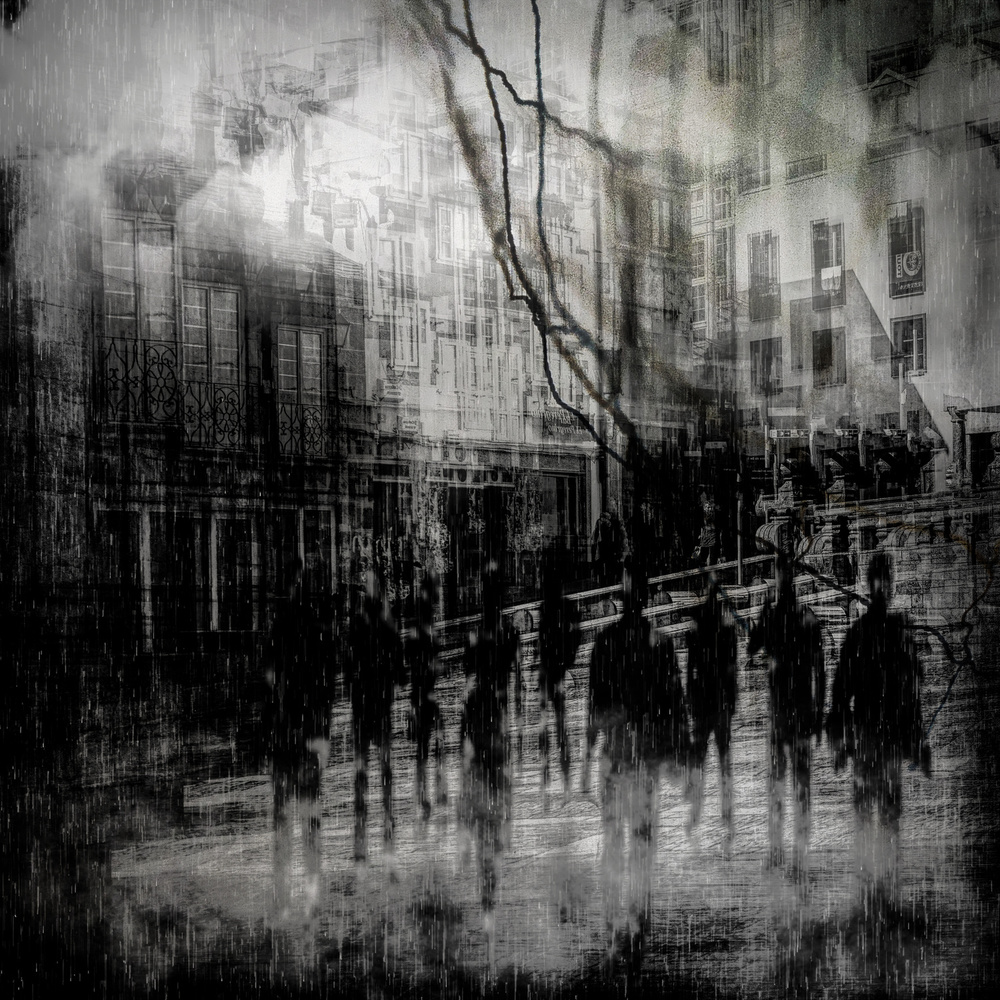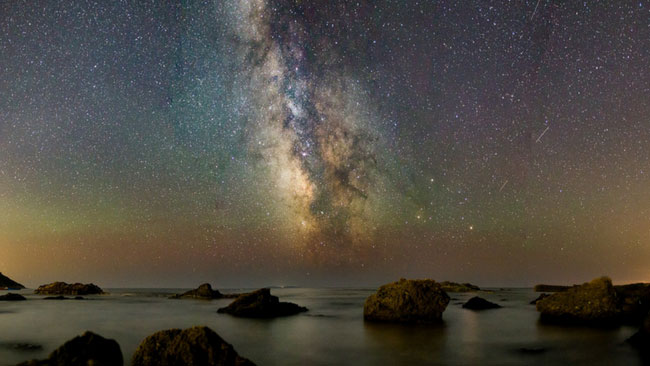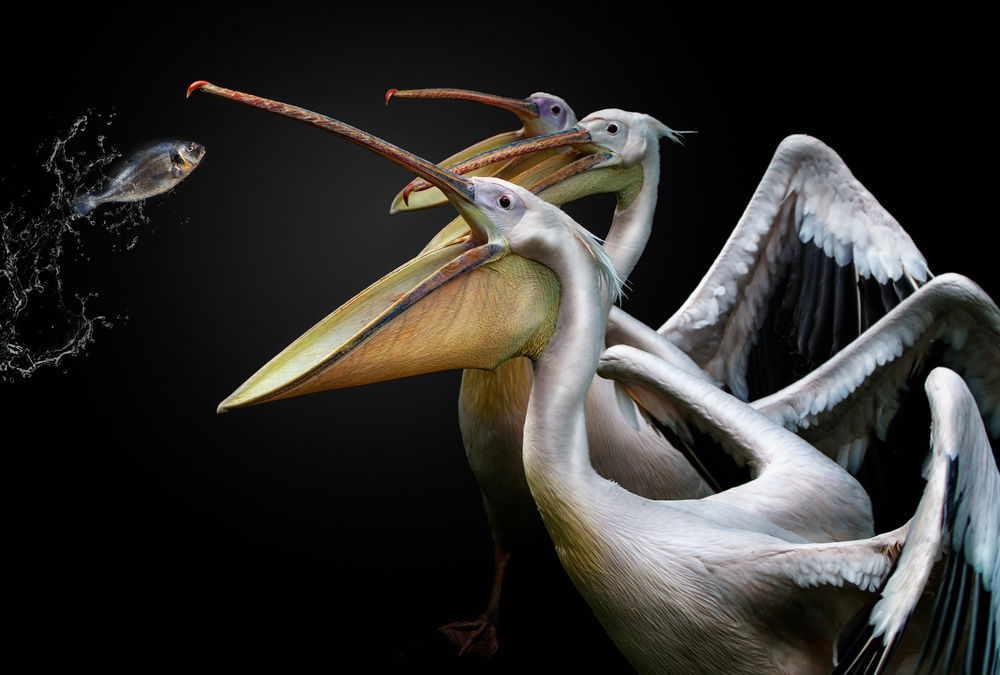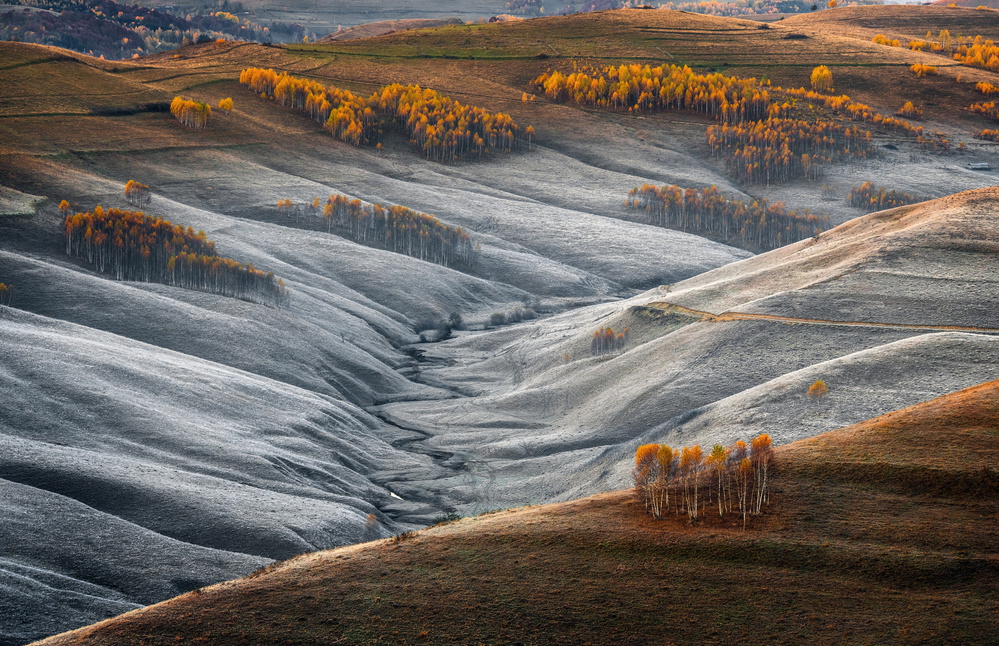Photographers

Photographer of the week: Gus
1x Blog-PhotographersThe artworks of Gus are contemplative and invitations to meditate. His images depict subjects like they are fading away in the viewer's imagination. They are inspired by the ideas he carries in his mind and he always gives them a dreamlike quality. He captures the essence of the transient nature of life.
Thanks to this interview, we can have a better glimpse on Gus' poetic soul and charming personality.
Briefly tell us about yourself, your hobbies and other jobs, dear Gus.
First of all, Yvette, I would like to say thank you for this interview, it’s an honour and I wish it helps to entertain readers and let them know a little bit more about me.
My real name is not Gus but Gustavo, but I’ve been named like this since I was a child so I always introduce myself that way. I live in the Balearic Islands from 2003, in a small village called Puigpunyent, located in the heart of the Tramuntana mountain range of Majorca. I share my days with my wife, my two years old daughter and my two dogs, and I work in the same Spanish company for several years.
Concerning to my hobbies, I obviously love photography and edition but, I also love reading, watching moovies (specially classic cinema), listening to a lot of different kind of music (from classics as Bach, Mozart or Brahms to Metallica or AC/DC, always depending on my state of mind) and, if I have some free time, I like to go walking although I can’t doing it as much as I would love to because of some healthy problems. All these activities are important for me but not as much as spending time with my family, the most important part of my life. I think that’s a good draw of myself in few lines.

How has your history and life experiences affected your photography?
Definitely yes. There’s an important part of my workpieces that come from my unconsciousness as if I were recovering past experiences from my childhood or teenage and also from my youth dreams. In some others, I try to show my personal way of gazing at reality, those things that worry me or just call my attention for any reason. I also try to express my fantasies. I think fantasy cannot be imprisoned, we must let it flow. The feeling of being free in that fantasy world is something that really makes me enjoy a lot.
Which are your most important experiences that has influenced your art?
As I told before, daily life, past experiences and the way I would like the future to be are the strongest influences for me to create. When I see something that is happening right here, right now, I always try to imagine the other side (of that reality) that I can’t see and, if I don’t find that “other side” then I create the scene as I would love it to happen (that’s the point of view of a very good friend of mine).

What first attracted you to photography?
When I was a child my father was often shooting (only for pleasure, non professional purposes) with a small compact camera. Sometimes he let me play a little bit with it and I loved that. However I think it was my curiosity, the willing of learning about everything… when I was very little I started collecting editions of National Geographic magazine (one more hobby to add to the list), and I always got absolutely amazed with those beautiful pictures, and the I searched information about those photographers, trying to learn more about that world. It helped a lot the fact that I’m an awful painter but I love artistic paintings and draws and, as that was something impossible for me to do, photography helped me to do what my hands weren’t able to do.

“Looking fog in the rain”
Describe your overall photographic vision.
It’s not easy, as you know, the most my workpieces are highly edited photographies. All of them start from one or more photos but I love to print my personal touch on them, play with them and try to get further.
Nowadays, in this digital age we live, there are thousand of wonderful edition programs which give us the opportunity of creating beautiful and unique works. Now we have the chance of seeing a picture behind the eyes of the artist and that’s something great. So, why should we accept one basic view? Why not exploring and showing what we have in our minds?
I don’t want to be misunderstood, I love seeing those beautiful landscapes, portraits or macros that some brilliant photographers are able to create. I also take these kind of photos but not with enough quality to be exhibited so, I keep them for myself and I focus my time in getting pictures of my own vision of reality. Sometimes I succeed and sometimes I don’t, but that’s what keeps me trying on.

“Spring and rainy day”
Why are you so drawn by creatively edited photography?
Because this is my world, my fantasy, what I would like to see and share with the rest of people, my dreams captured in a picture forever. Photography lets you capture an image by the moment you click the button while I capture forever this imagined reality of my mind, what I’m thinking at that moment or even during several days flows out and becomes a reality. I could compare it with having a child (not literally, of course), but it is your own creation, a part of yourself becomes printed in an image forever. With creative edition I can show something that cannot be seen by the rest of people, something that can only be seen by me, and this is the only possible way to get that.
I hate those moments after waken up when I try to remember what I’ve been dreaming of, but I can only remember some small pieces of the story.
When I’m editing an image I let all my thoughts flowing out and then I know this moment won’t be ever lost, it is like a dream catcher, from then on, I can daily enjoy that imagined moment for the rest of my life.

“Poppies Fantasy”
What is more important to you, the mood,/story behind your images or the technical perfection?
Both of them walk together, are necessary and complementary, though you can get a perfect edition but if you cannot transmit your feelings about that, the story, the image lost its essence to 90%. You can get very beautiful images but simple and plain, without meaning… I’ve declined workpieces for this reason several times, when I look to an image once and again but I can’t find what I was looking for, this image is not worthy at all for me.

“Innsmouth”
What generally is your relationship to your subject matter beyond being an observer?
I try to take part of the action, be surrounded by the image, feel it and walk through it. I try to get involved with the moment and join it. My workpieces are very varied, sometimes I introduce human beings but I always try to integrate them into the rest of elements, not with a main role but as a simple part of the scene… I don’t always get it and the human being becomes the most important part of the picture but that’s life, humans are the main character in world happenings.

“The network”
Do you prepare carefully the locations where you are intending to photograph?
Almost never, excepting when I want to shoot a landscape. Most of my pictures are done during the weekend when I get out for a walk with my wife and daughter. Some others are made while I'm walking alone, I always carry a small Pentax Optio just in case I see something interesting, or even my i-Phone has been a good option for a quick shoot. Actually, the most part of my photos are spontaneous or just the result of few minutes thinking about it.
Nowadays I’m doing some more urban photos and, for this type of images I try to select spots to get the picture I’m looking for. I’ve selected some nice ones and I’ll start editing them soon. “Afternoon rain” belongs to these new collection, I saw it making a review and I couldn’t help start with the edition. The rest will be done bit by bit.

“Change of the world”
What gear do you use (camera, lenses, bag)?
I usually work with my Canon EOS 80D using several lenses as 11-16mm, 50mm, ND NISI filters, different kind of stands and a lot of accessories as filters, intervalometer, cables, etc.
I also use a Canon EOS 400D modified to infrared photography, but by the moment I’m not getting good results, I’m insisting quite a lot, I wish someday I’ll get a good photo with it. I use it with a canon 17-85 lens.
And a Leica with Summilux Vario 24-75 mm ASPH
What software do you use to process your images?
I use Adobe edition pack which includes Photoshop, Lightroom desktop version and CC and Camera RAW. I also use Topaz filters and pluggins pack and sometimes Nick Color. I’ve tested some others as ON1 Photo Raw but I always turn back to Photoshop and lately I use more and more Lightroom for the first “development”.

“Homesickness”
Can you tell us something more about your work flow?
It depends on my state of mind at the moment I decide to start doing something. I usually imagine the scene I would like to get before I take it, for example, “The farmer and old olive”, I took that picture one Saturday morning while I was walking with my daughter along the village we live in. We passed near an old olive tree and I looked at it, alone, separate from the rest and then I remembered that when I was a child, at the village I was born, farmers used to join each other to talk about life under a tree (after doing a lot of hard work) until the sunset came. That tree made me remember that and I had clear in mind what I wanted to do. After shooting the tree, edition helped me to show what I was thinking and remembering, that feeling coming from the past.

"The farmer and old olive tree"
Not a long time ago a my tutorial on “Alone ship” was published and that’s a good line to follow what I commonly do. To read it click here.

“Alone ship”
To start with the edition process I usually work in Camera RAW or Lightroom to configure first settings, then I take it to Photoshop and I start searching the way of getting that image that I can see in my mind printed on the screen,using for that many filters and Topaz pluggins depending on the result I want to reach: if is something in the style of impressionists paints as “Daisies” or something more abstract as “Way of freedom”… sometimes I try to find something less aggressive with the original image and I just go testing different options.

“Daisies”

“Way of freedom”
Sometimes, the idea comes while checking pictures in my folders, for example, “Walker” is a picture I took more than 10 years ago, I just saw it and then I had clear in my mind what to do with it. “Rainy day” comes also from that time… many of my workpieces come from the past.
There’s something I use to do very often: when I finish edition, I don’t close the file and I leave, go for a walk or, sometimes I don’t look at it again for days (I completely forget it) and then, when I sit down in front of the screen I look at it with the perspective of time, I look at it from the outside and then, I decide if it makes me feel what I was looking for, if it needs some improvements or if I can throw it away because it doesn’t transmit any meaning for me.
What is your most important advice to a beginner in creatively edited photography and how do you get started?
The first and most important thing is being yourself, search your own way and don’t try to do it too fast. If you are lucky this is a long way to learn if you really want to get better and better. Creative edition is not only making a mix of different pictures but knowing what do you exactly want to transmit or what do you want to get with your works.
It’s important not to be focused on just one style but trying the most as possible: landscapes, portraits, social, … and then start working on them until you get the desired result.
Continuous education is basic, not only about creative edition but all contents involving photography, I watch a lot of tutorials (some of them many times) about things that seem simple and easy but they aren’t, for example how to use Lightroom properly. It’s important to read a lot and see as much photos as possible to analyse them and learn of it. I recently finished reading Ansel Adams trilogy “The camera”, “The negative” and “The print” and although it seems it’s far from creative edition, it teaches you the right system to measure the light and that’s something that should be studied by any photographer. It doesn’t mean you are going to get similar results to Ansel’s photos, he is out of the world, but it changes your point of view. I will read again those three books until I can understand them deeply.
Sharing opinions and doubts with other photographers is also very good. It helps me a lot to be in contact with 3 or 4 photographers and speak about our workpieces, sharing impressions about them… sometimes this contact becomes a friendship and that’s nice. Instead of thinking you are reaching the top with your work, it’s important to keep on learning and be conscious that there are always thousand of things to be improved and if you keep on studying and learning you won’t ever get stuck.

“The Promise”
Who are your favourite photographers and more importantly, how has your appreciation of their work affected how you approach your own photography?
This is one of the most complicated questions to answer, I liked so much artists that is difficult to try just some of them, but I’m going to try it, I’ll focus my selection in my 1x colleagues.
Carla DLM is a reference for me. The way she works is amazing, she has introduced a lot of new creative techniques as distortion and divergence lines in her wonderful multiexposure… some others have tried to follow her steps but, honestly, they are very far from her results. Her creativity is huge.
The genius Ben Goosens, his creativity and imagination, his surrealist and sometimes sarcastic humour, and his wonderful technique are admirable.
Sherry Akrami is not so “humoristic” but her creativity and techniques are awesome.
Hadi Malijani is another great creative artist.
The breath-taking George Digalakis’ B&W, the peacefulness he transmits, his subtlety details drive me crazy, is one of my favourites. He is a master in long exposition photos.
In landscapes, there are many good ones I really like but, I would choose Martin Zalba, not only because of his amazing workpieces but for his way of working (I know him well). He searches highest quality at any shot and puts the 100% of himself in every picture he work on. He is also a good researcher about infrared photos. Under my opinion he is one of the best nowadays landscape photographers.
But, if I finally have to choose one, taking into account the whole body of work (analogue and digital) that person would be Sol Marrades. Her career is huge. I’ve been lucky to see some of her analogue multiples exposures work and they are incredible. In digital photography we only have to click and we are not able to reach her perfectionism. The plasticity in her works is amazing, those “thrilling” B&W full of contrasts giving as a result an awesome creative and innovative workpieces… it’s understandable that her photos are exposed all around, and it was a very nice surprise for me finding her on 1x. There’s no picture of Sol that can be ignored.
Is there any specific photo taken by another photographer that has inspired you a lot and why?
The image “Water Lilies” by Frans Lanting, a National Geographic natural environment photographer, always has been fascinating for me.
It’s a part of a project he did in Okavango Delta. Every time I look at that picture it hypnotizes me for a while, although its hanging in one of the walls of my house I see it daily and I always find a new detail or I imagine something different… for me, It’s awesome. It’s far from my style but I find it very special.
Are there any specific directions that you would like to take your photography in the future or any specific goals that you wish to achieve?
I’m very interested on long exposure photography.
I’m also interested in multi exposures, directly with the camera or by using several pictures during the processing. I think this is a good way of creating and imagine impossible situations. I’m practising both of them at this time.
Describe your favourite photograph taken by you and why it is special to you?
My personal favourite for many reasons. It’s “El Torrellon”, a tiny island with a group of Eucalyptus located just a few meters from the house I was born in Castropol (Asturias, north of Spain). When I was a child I used to swim in that beach and I spent a lot of time reading or listening to music alone in that island, gazing the sea.
It is also because I took this photo following George Digalakis’ advice and taking into account what I read in his blog when I was researching information about long exposition photography.
This location is very special for me and I particularly like the result of this B&W. I never sent it to curation but I want it to be there, in my portfolio, ready to be envisioned once and again. I’m also very happy that some photographers have chosen this picture as a favourite, some of those, important professionals for me who I admire a lot.
Is there anything else you wish to add and what do you think about 1X as a home base for your work?
Little more I have to say ... I see that my work has very good acceptance in different online galleries and this is something that fills me with satisfaction while it serves as encouragement to continue exercising imagination and creativity, something that particularly like ... and also is my main objective.
. '









